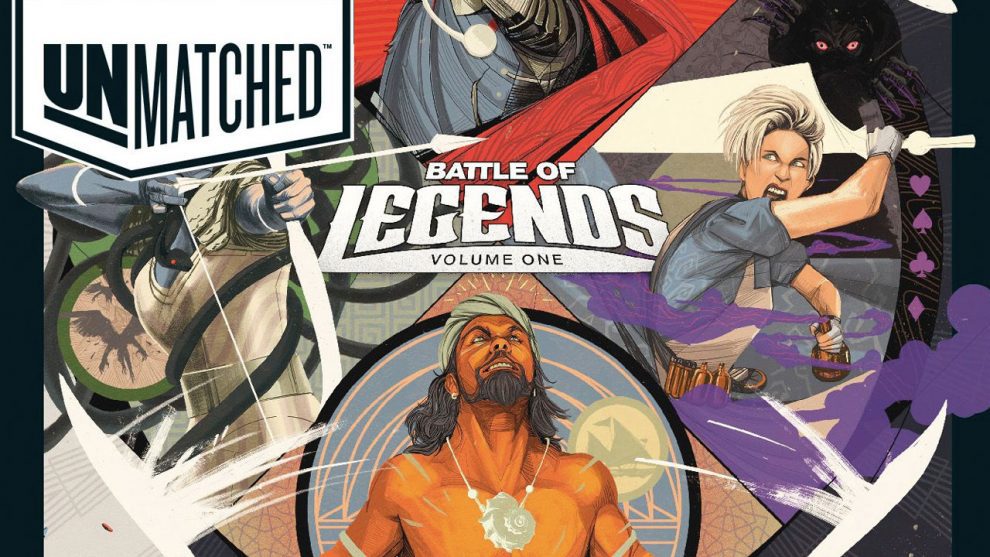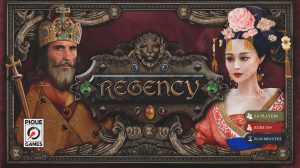The concept of fictional characters from various settings then fighting it out isn’t new to gaming. For video games, there is Nintendo’s Smash Bros series and for board games, there is the classic Heroscape. Unmatched sets itself apart by having its roster filled with notable literature and licensed characters such as Sinbad, Big Foot, and Bruce Lee. Combine this unorthodox cast with a card combat system designed for a mainstream audience and it sounds like the makings of a great game.
This is the part of the review where I talk about what roles the players will partake in but I don’t think that’s necessary since I gave it away already in the first paragraph. You and your opponent pick a character, place your character and sidekick on a gorgeous map, then yell numbers at each other until one of you can’t do it anymore. Maybe I’m oversimplifying this a little bit since you do need to play cards to commence the yelling.
Before You Yell
Each character has a specific deck and it consists of combat cards and scheme cards. Your combat cards come in three flavors: Attack, Defense, and Versatile. The first two you already know but Versatile allows you to play it as either Attack or Defense. Each combat card has a number associated with it which determines the card’s strength with higher numbers being the better outcome. Scheme cards are non-combat cards that allow you to perform a potent text effect.
On your turn, you have two actions and you can do three different types. Maneuver makes you draw a card then you have the option to move your character or sidekick around the board. Scheme allows you to play a Scheme card and do whatever the text says. Combat requires a few more sentences so let’s move onto the next paragraph.

If your character is melee oriented, you have to be adjacent to your target to attack. Range characters only need to be in the same color circle as their target to attack. This is how the game handles “Line of sight” and I am so grateful for this because LoS tend to be obnoxious in these games. You will then play an attack card facedown and your target has the option of playing a defensive card facedown. Both of you will reveal your cards, card effects will take place, and whoever has the higher number wins. If the defender wins, no damage is dealt. If the attacker wins, the damage is dealt and the amount of damage is the difference between the attack number and defense number.
As you can tell by the rules, this is a very straightforward game that can easily be explained in a few minutes. Most of the “complications” come from the card text and the rulebook does an amazing job of clarifying everything including any potential edge cases. It’s a game where you and your opponent will dance around the board with the occasional clashing as both of you are evaluating the board state and push any sort of meager advantage you think you have. Throw in one of the most gorgeous artworks that I have seen in almost any medium and this sounds perfect.
Not A Fan
I want to like this game.
The first glaring problem is the card play itself. You need particular cards to do combat actions and if you don’t, you simply can’t do it. This system railroads decision-making and has very little to do with you. If you have a hand of attack cards, you know that slapping King Arthur is a bad idea. Since you can’t defend their counterattack, your only option is to Maneuver around the board to draw cards. Didn’t get any Versatile or Defense cards? Maneuver some more. This isn’t an interesting scenario to be in.
Let’s just say you have a good mixture in your hand. You are ready to trade blows with your opponent so you decide to throw down cards and yell numbers. This leads to a few hits or misplays and now your hand looks terrible. Your only option here is to Maneuver to draw more cards. The entire game is scripted with this constant back and forth between Maneuvering and Attacking. There might be some situations where you want to Maneuver while your opponent wants to Attack, but that’s driven by card draws and not an inherent decision.

An argument can be made that this is the nature of card-based combat and there is some truth in that. However, I have seen plenty of other games that have similar to mechanisms executed far better than what is presented here. I’ll name the first game that came into mind when I was reading the rules: Yomi.
Like Unmatched, Yomi is a game about beating your opponent into submission using rock-paper-scissors instead of numbers. Both games use card draws to give you options and involve playing cards face down. Similar to Unmatched, the cards are revealed to determine who the winner is. The key difference here is Yomi has a different move on both sides of the card and you pick one side. Not only does this give you plenty of options on how to approach the fight, but it also introduces a cost-opportunity problem you must deal with.
While it is true that cards will have certain abilities that break the rules, the issues lie within the lack of context to use them. Unlike games like Magic the Gathering, Keyforge, or Monolith Arena, you aren’t building towards a strategy. Every single card in this game is a one-shot affair. The game relies on you making timed plays strictly based on what resides in the opponent’s discard pile meaning any “good card plays” is more of fortunate circumstances instead of skillful procedures.
Different Strokes
When it comes to asymmetrical character design in competitive games, there are two camps. On one hand, you can have a character with a variety of different powers and it is up to you to interpret these tools however you see fit. The other side of this are powers that cultivate a particular play style, and your role is to try to execute that play style as best as you can. Unmatched leans on the second side of this design philosophy.
I’ll give two examples to illustrate this point: Sinbad and Medusa. Sinbad is a slow-moving character with weak attack cards at the start of the game and his sidekick, Porter, is designed to draw cards. For Sinbad to become stronger, he needs to play his Voyage cards. For each Voyage card in his discard pile, his movement is increased by 1 and all future Voyage attack cards will gain 1 additional damage for each Voyage card in the discard.
Medusa is a different beast. She starts with four harpy sidekicks and her attacks are ranged. Her task is harassing her opponents from a distance while her harpies will blockade and control the traffic of their opponent. Medusa’s defensive cards are focused on disarming their target by forcing them to discard cards, paving the way for Medusa to play her borderline fatal move, Stonegaze.
While the above is an interesting scenario to a part of, the problem is these characters will play exactly in every single match with very little concern who their opponent is. Sinbad will always use Porter to dig through the deck to grab those Voyage cards. There is no reason for Medusa not to annoy her opponent with ranged attacks while her harpies play border patrol.
Characters specializing in one aspect of the game isn’t the problem itself. I would so far as to say this concept is preferable in games where you form a team of characters since you will need to figure out a strong synergy without feeling overwhelmed. The complication with Unmatched is it tries to be 1 vs 1 skirmish game with barely any interesting tools to mess around with. Yes, the box does say 2 to 4 players but 3 player games are abysmal while 2 on 2 would be my preferred choice if the game didn’t devolve into “two players attack one player” in every single match.
I didn’t come into Unmatched with sharpened knives ready to cut this game into bits. Like many others, I was enamored by the production and concept. Based on the previews, it looked like something that I can easily teach while providing a competitive vibe. The result was a game that felt reliant on licensed or famous characters instead of entrapping the player with intriguing mechanisms. There are lots of other competitive games out there that fill the same time frame and price range as Unmatched but have performed far better than what is presented here.
You can purchase this game at Amazon US












I want to know this other games that do it better than Unmatched. Would love to know because I’m loving this game.